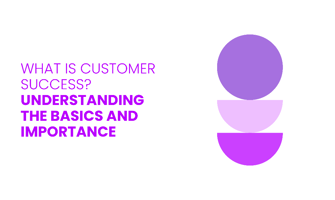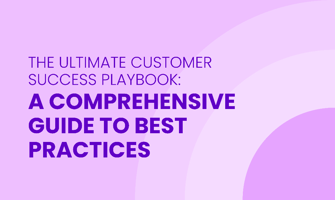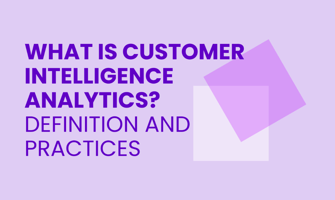Customer success helps customers succeed with products or services they buy. It’s different from...
Customer Lifetime Value Prediction: Significance and Applications
Understanding how much a customer is worth throughout their relationship with a business is critical for making informed marketing and sales decisions. Customer Lifetime Value (CLV) prediction helps businesses estimate the total revenue a customer is expected to bring during their engagement.
By utilizing advanced analytics and predictive models, companies can focus on the most valuable customer segments, optimize acquisition costs, and improve retention strategies, ensuring sustainable growth. This article explores why predicting customer lifetime value matters and how businesses can use it effectively.
Explore "revenue intelligence" in detail by reading: "What is Revenue Intelligence? How It Works and Why It Matters."
![]()
What is Customer Lifetime Value Prediction?
Customer Lifetime Value (CLV) prediction is important for understanding how much revenue a customer might generate for your business over their entire relationship with you.
At its core, it’s about estimating a customer’s total worth to your company in the future, which helps you make smarter decisions about how to interact with them.
To start, it’s important to recognize the difference between two related ideas: CLV and CLV prediction. CLV is a fixed number that represents the total monetary value a customer has brought to your business so far.
On the other hand, CLV prediction is forward-looking. It estimates the future revenue a customer is likely to bring, making it a dynamic and adaptable tool for planning. The foundation for understanding CLV prediction often begins with a simple formula:
CLV = (Average Purchase Value) x (Purchase Frequency) x (Customer Lifespan)
This formula gives you a rough idea of what a customer might contribute to your business. However, when predicting CLV, businesses take this basic calculation further by using advanced models and techniques.
These methods account for variables like changing customer behavior, market trends, and other factors that influence future spending.
Why is CLV Prediction Important?
Understanding why Customer Lifetime Value (CLV) prediction is important can reshape how businesses interact with customers and make decisions. It helps you focus on what drives growth and profitability by identifying which customers matter the most to your business.
One key benefit of CLV prediction is that it enables you to identify and retain high-value customers. These are the customers who bring the most revenue to your business over time.
By predicting their lifetime value, you can take specific actions to keep them loyal, like offering personalized deals or better customer support. Retaining high-value customers isn’t just good for loyalty it also reduces costs. Acquiring new customers is often more expensive than keeping existing ones satisfied.
CLV prediction also plays a key role in optimizing marketing strategies. With a clear understanding of each customer’s value, you can decide where to spend your marketing budget for the best results.
For example, you might invest more in campaigns targeting high-value customers or create tailored messages for different customer groups. This targeted approach leads to better marketing ROI because you’re focusing on activities that generate more profit.
Another advantage of CLV prediction is that it supports better resource allocation. Businesses have limited time, money, and staff, so it’s important to use them wisely. CLV prediction helps you prioritize resources by directing them toward your most valuable customers.
For example, you might provide premium services or faster response times to customers who are likely to spend more. This focus on high-value customers helps you drive long-term business growth by building stronger relationships with the people who help your business thrive.
In short, CLV prediction gives you the ability to make smarter decisions. By identifying high-value customers, improving marketing efficiency, and allocating resources effectively, you can boost profitability and build a business that lasts.
How CLV Prediction Works
1. Data Collection
To predict customer lifetime value (CLV) accurately, everything starts with the right data. Without gathering accurate and relevant information, the foundation of any prediction becomes unreliable.
This makes data collection one of the most essential steps in the entire process. You need to focus on collecting data that truly reflects customer behavior and interactions with your business. Several types of data play a critical role in CLV prediction:
-
Transactional data: This includes purchase history, order frequency, average order value, and total spending. It helps you understand how much a customer has contributed to your business financially.
-
Customer demographics: Information such as age, location, gender, or income level can provide insights into customer profiles and buying patterns.
-
Website activity: Data on how customers interact with your website—like time spent on pages, browsing history, or abandoned carts—can provide clues about their interests and intent to purchase.
Each of these data types brings something unique to the table. For example, transactional data shows you past behaviors, while website activity reveals potential future actions. Together, they create a clearer picture of the customer’s value to your business over time.
2. Prediction Models
Prediction models are important for understanding and projecting customer lifetime value (CLV). These models help you analyze customer data to estimate how much revenue a customer might bring to your business over time.
By using the right tools and methods, businesses can make smarter decisions and improve their strategies. There are two main types of models for CLV prediction: traditional models and modern machine learning models. Each has its strengths and fits different use cases.
Traditional Models:
Traditional models are simpler and rely on established statistical methods. Here are a few common ones:
-
Historical-Based Models: These models calculate CLV based on a customer's past purchases. They assume that future behavior will mirror past behavior. While straightforward, they might miss changes in customer habits.
-
RFM Models (Recency, Frequency, Monetary): These use three factors how recently a customer made a purchase, how often they buy, and how much they spend. RFM models are easy to apply but can oversimplify customer behavior.
-
Cohort Analysis: This groups customers based on when they started doing business with you. It tracks their spending patterns over time. Cohort analysis works well for spotting trends but might struggle with individual-level predictions.
Machine Learning Models:
Modern approaches rely on machine learning to find patterns in customer data and make more accurate predictions. These models adapt to new trends and handle large datasets better. Some common types include:
-
Regression Models: These predict CLV by identifying relationships between variables, like age, location, and spending habits. They are useful for finding key drivers of customer value.
-
Decision Trees and Random Forests: These models split data into smaller groups based on rules, like "Does the customer spend more than $50 per visit?" Random forests combine many trees for better accuracy.
-
Neural Networks: Inspired by the human brain, these models analyze complex data relationships. They are powerful for handling unstructured data, like text or images, but require significant computational resources.
-
Clustering Algorithms: These group customers based on similar traits or behaviors, making it easier to predict CLV for each group. Clustering is especially useful for customer segmentation.
Machine learning models are becoming more popular because they handle complexity better than traditional methods. They can process large amounts of data quickly and learn from it to improve predictions over time.
For example, machine learning can detect subtle patterns, like how seasonal trends affect customer spending. This adaptability makes them especially valuable in dynamic markets. By choosing the right prediction model for your business, you can better understand your customers and plan for the future.
3. Implementation in Business
Applying customer lifetime value (CLV) predictions in a business setting can drive smarter decision-making and improve overall performance. By turning data into actionable insights, businesses can use CLV predictions to improve customer interactions and maximize returns on their investments.
One key way businesses implement CLV predictions is by integrating them into Customer Relationship Management (CRM) systems. When you combine CLV insights with your CRM, it becomes easier to personalize how you interact with individual customers.
For example, if the data shows a customer is highly valuable, you can prioritize offering them exclusive deals or faster support. On the other hand, for customers with lower potential value, you might focus on more cost-effective communication methods.
Another area where CLV predictions prove valuable is in creating and optimizing targeted marketing campaigns. Businesses use CLV data to design campaigns that focus on high-value customers or those with the potential to become more valuable.
For example, if CLV analysis identifies a group of customers likely to purchase premium products, you can create ads or promotions specifically tailored to that group. This ensures marketing dollars are spent where they’re most likely to generate a strong return.
Here’s how businesses apply CLV predictions in these areas:
-
Tailored Offers and Discounts: High-CLV customers might receive personalized discounts or loyalty rewards to keep them engaged. For lower-CLV customers, general promotions might suffice.
-
Channel Selection: Businesses use CLV insights to choose the right communication channel. For example, high-value customers might get personalized emails or calls, while others might receive general ads through social media.
-
Customer Retention Strategies: By identifying customers at risk of leaving, businesses can use CLV data to intervene with retention offers that align with the customer’s value.
-
Product Recommendations: CLV predictions help suggest products that match a customer’s preferences and spending habits, increasing the likelihood of repeat purchases.
These applications make CLV prediction a practical tool for improving both customer satisfaction and business profitability.
Platforms like 180ops assist businesses in integrating Customer Lifetime Value (CLV) predictions with their CRM systems, making it easier to identify high-value customers and personalize interactions to improve loyalty and profitability.
![]()
Applications of CLV Prediction
1. Personalized Marketing
Personalized marketing is all about offering the right products or services to the right people. Customer Lifetime Value (CLV) prediction makes this possible by helping you understand your customer’s preferences and behaviors in detail.
Using CLV prediction, you can design targeted offers that match what each customer is likely to want or need.
For example, if a customer frequently buys athletic wear, you can send them special discounts on running shoes or gym accessories. This approach ensures your offers feel relevant, increasing the chances that customers will respond positively.
CLV prediction also enables you to deliver customized recommendations. By analyzing past purchases and predicting future behavior, you can suggest products that align closely with what a customer is likely to buy next.
If someone recently purchased a smartphone, you might recommend compatible accessories like cases or headphones. This level of personalization can make shopping easier and more enjoyable for customers.
When customers receive offers and recommendations that genuinely fit their needs, they feel understood and valued.
This improves their satisfaction and engagement, which encourages them to stick with your business over time. Loyal, happy customers are often the most profitable, making personalized marketing a win for both businesses and customers.
2. Customer Segmentation
Identifying which customers bring the most value to your business is important for making smart decisions. Customer Lifetime Value (CLV) prediction helps you do exactly that by showing who your high-value customers are.
These are the people who are likely to spend more, stay longer, and contribute most to your revenue. With this insight, you can focus your resources like marketing budgets, customer service efforts, or loyalty programs on these customers to get the best return on investment (ROI). For example, you might offer exclusive deals or personalized experiences to keep them engaged.
On the other hand, CLV prediction also helps you spot low-value customers. These are individuals who are less likely to make repeat purchases or who contribute only a small amount to your overall revenue.
By recognizing these segments, you can avoid overspending on them. For example, instead of offering costly promotions to customers who are unlikely to respond, you can redirect those funds to areas with higher potential returns.
This dual focus on both high-value and low-value groups allows businesses to:
-
Prioritize high-value customers with tailored strategies that maximize ROI.
-
Reduce costs by limiting investments in low-value segments.
Ultimately, CLV-based customer segmentation helps you allocate resources where they matter most, ensuring your business grows efficiently and sustainably.
3. Resource Allocation
Allocating resources wisely is important for any business. Customer Lifetime Value (CLV) prediction helps you do this by showing which customers are most valuable over time. With this knowledge, you can make strategic decisions that maximize returns and improve efficiency.
For example, when planning your marketing budget, CLV prediction allows you to focus on high-value customer segments. Instead of spreading your budget thin across all customers, you can invest more in those who are likely to spend more or stay loyal for longer.
This means prioritizing campaigns that engage these key groups, whether through personalized offers, loyalty programs, or targeted ads. Beyond marketing, CLV prediction helps you optimize customer service resources.
By identifying customers with higher predicted lifetime value, you can prioritize their needs. This might involve offering faster support, assigning experienced agents, or providing exclusive perks to these individuals.
It ensures that your resources go where they will have the greatest impact, improving satisfaction for high-value customers while keeping costs under control.
In both cases, the cause-effect relationship is clear: focusing on high-value customers leads to better resource allocation, which directly supports sustained financial growth and stronger customer relationships.
4. Forecast Revenue Growth
Predicting customer lifetime value (CLV) plays a critical role in helping businesses estimate future revenue. By analyzing customer behavior and purchasing patterns, you can gain insights into how much revenue each customer is likely to bring over time.
This allows you to make informed decisions about growth strategies and financial planning. One way CLV prediction supports forecasting is by breaking down customer activity into patterns. For example:
-
Purchase frequency: How often customers buy from you helps determine their ongoing engagement.
-
Average order value: Knowing how much customers spend per transaction shows their spending habits.
-
Retention rates: Understanding how long customers stay loyal to your business gives insight into long-term revenue potential.
By studying these patterns, you can estimate how much revenue your current customer base will generate in the future. This is especially helpful for managing cash flow and setting realistic financial goals.
CLV prediction also helps identify areas where your business can grow. For example, you might notice that certain customer segments consistently have higher CLV.
This can reveal opportunities to expand in those profitable segments or create tailored strategies to attract similar customers. Additionally, you can use CLV data to upsell or cross-sell to existing customers, maximizing the revenue they generate.
Challenges in CLV Prediction
Predicting customer lifetime value (CLV) is a powerful tool, but some challenges can affect its accuracy and usefulness. Understanding these challenges helps you approach CLV prediction more effectively and make better decisions.
One key issue is data quality and availability. CLV predictions rely heavily on accurate and complete data. If your data is outdated, inconsistent, or missing key details, the predictions you make might not reflect reality.
For example, incomplete purchase histories or incorrect customer information can lead to flawed results. Ensuring that your data is both reliable and comprehensive is critical for achieving dependable predictions.
Another challenge comes from dynamic and evolving customer behaviors. Customers don’t behave the same way over time. Their preferences, habits, and purchasing power can shift because of factors like new trends, economic changes, or personal circumstances.
This makes it difficult to predict how valuable a customer will be in the long term. Even small changes in behavior can ripple through your predictions, affecting their accuracy.
Choosing the right prediction models is also a major challenge. Different businesses operate in unique environments, and no single model works perfectly for every situation.
You have to select a model that fits your specific needs while also considering the complexity of implementation. On top of that, even well-chosen models require constant adjustments to remain accurate as market conditions and customer data evolve.
Conclusion
Customer Lifetime Value prediction serves as a vital tool for businesses aiming to enhance profitability and build stronger customer relationships. By identifying high-value customers and tailoring strategies to their needs, companies can allocate resources effectively and drive long-term success.
As technology and data analysis continue to evolve, CLV prediction remains a cornerstone of customer-centric strategies, offering businesses a competitive edge in today's data-driven environment.
FAQ
1. What is Customer Lifetime Value (CLV) prediction?
Customer Lifetime Value (CLV) prediction involves estimating the total revenue a customer is expected to generate for a business over their entire relationship. It uses data analysis and predictive models to determine how valuable a customer is likely to be in the future.
2. Why is CLV prediction important for businesses?
CLV prediction helps businesses identify their most profitable customers, optimize marketing spending, and improve retention strategies. It enables companies to focus on building long-term relationships with customers who bring the highest value.
3. How do businesses calculate CLV?
Businesses calculate CLV using various models, including historical data analysis, predictive analytics, and machine learning algorithms. Key factors include purchase frequency, average order value, customer retention rate, and customer acquisition costs.
4. What industries benefit the most from CLV prediction?
CLV prediction is widely used in industries such as e-commerce, retail, SaaS, hospitality, and financial services. Any business that relies on repeat customers or subscription models can significantly benefit from understanding and predicting CLV.
5. How can CLV prediction improve customer experience?
By identifying high-value customers, businesses can personalize their marketing efforts, offer tailored discounts, and enhance customer support. This targeted approach improves customer satisfaction and fosters loyalty, resulting in better overall experiences.




